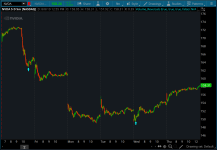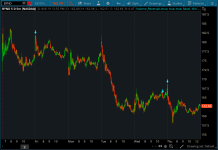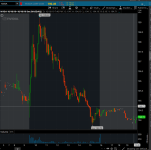This indicator is just a simple modification of the original script called SJ_VSA_Reversals that was based on Volume Price Analysis (VPA). Someone wanted to turn the bubble signals into arrows so here it is.
With the arrows, it just makes it easier for the signals to be displayed on your chart. Moreover, you can use it to scan for new signals on the hourly, daily, etc. The Volume Reversals indicator also come with alerts (by default from the original).


With the arrows, it just makes it easier for the signals to be displayed on your chart. Moreover, you can use it to scan for new signals on the hourly, daily, etc. The Volume Reversals indicator also come with alerts (by default from the original).
thinkScript Code
Code:
# Volume Reversals Indicator
# Original SJ_VSA_Reversals (found in thinkScript Lounge)
# Modified by BenTen at useThinkScript.com
# Replaced chart bubbles with arrows
# Arguments
def length = 40;
def displace = 0;
def volumeEMALength = 30;
def narrowSpreadFactor = 0.7;
def wideSpreadFactor = 1.5;
def aboveAvgVolfactor = 1.5;
def ultraHighVolfactor = 2;
def highCloseFactor = 0.70;
def lowCloseFactor = 0.25;
def GdojiFactor = 0.2; # C_RP
def WickFactor = 0.1; # C_RP
def shortTermLength = 5; #C_RP
def midTermLength = 15; #C_RP
def longTermLength = 40; #C_RP
input colorBars = {false, default true}; #C_RP
input trendText = {false, default true};
input volumeDefinitions = { false, default true };
input alerts = { default false, true };
# Calculations
rec spread = high - low;
def median = (high + low ) / 2;
rec avgVolume = compoundValue(volumeEMALength, ExpAverage(volume, volumeEMALength), Double.NaN);
# Calculate Volume moving average and it's standard deviation
rec sAvgVolume = compoundValue(volumeEMALength, Average(volume, volumeEMALength), Double.NaN);
def sAvgVolumeSTD = stdev(sAvgVolume, volumeEMALength);
# check if the vloume has been decreasing in the past two days.
def isTwoDaysLowVol = (volume < volume[1] && volume[0] < volume[2]);
# Calculate Range information
def avgSpread = WildersAverage(spread, volumeEMALength)[0];
rec isWideSpreadBar = (spread > (wideSpreadFactor * avgSpread));
rec isNarrowSpreadBar = (spread < (narrowSpreadFactor * avgSpread));
# Price information
rec isUpBar = close > close[1];
rec isDownBar = close < close[1];
# Check if the close is in the Highs/Lows/Middle of the bar.
# C_RP 20100809
# original code - def x1 = if (close == low) then avgSpread else (spread / (close - low));
def x1 = if (high==low) then 2.0 else if (close == low) then 2.65 else (spread / (close - low));
# C_RP try the line below with various divisors totalSum result in a minimum of 2.3 on a spread of 1 pip instead of using a fixed 2.3 as in the line above
# def x1 = if (high==low) then 2.0 else if (close == low) then (spread / 0.43 ) else (spread / (close - low));
def isUpCloseBar = (x1 < 2);
def isDownCloseBar = (x1 > 2);
def isMidCloseBar = (x1 < 2.2 && x1 > 1.8);
def isVeryHighCloseBar = (x1 < 1.35);
# C_RP 20100809 added isVeryLowCloseBar
def isVeryLowCloseBar = (x1 >= 2.65);
# Trend Definitions
rec fiveDaysSma = compoundValue(5, Average(close, 5)[0], Double.NaN);
def LongTermTrendSlope = LinearRegressionSlope(price = fiveDaysSma, length = longTermLength)[0]; # 40
def MiddleTermTrendSlope = LinearRegressionSlope(price = fiveDaysSma, length = midTermLength)[0]; # 15
def ShortTermTrendSlope = LinearRegressionSlope(price = fiveDaysSma, length = shortTermLength)[0]; # 5
# VSA Definitions
# upTHRUST - CRITERIA
# utbar
rec isUpThrustBar = isWideSpreadBar && isDownCloseBar && ShortTermTrendSlope > 0 && middleTermTrendSlope > 0; #C_RP added positive middleTermTrendSlope requirement to filter out upThrusts in trends that are only short term. Consider adding longTermTrendSlope requirement as well.
# utcond1
def upThrustConditionOne = (isUpThrustBar[1] && isDownBar);
# utcond2
def upThrustConditionTwo = (isUpThrustBar[1] && isDownBar[0] && volume > volume[1]);
# utcond3
def upThrustConditionThree = (isUpThrustBar[0] && volume > 2 * sAvgVolume[0]);
# scond1
rec isConfirmedUpThrustBar = (upThrustConditionOne OR upThrustConditionTwo OR upThrustConditionThree);
# scond
rec isNewConfirmedUpThrustBar = (isConfirmedUpThrustBar[0] && !isConfirmedUpThrustBar[1]);
# Two Period UpThrust Bar
rec isTwoPerUpT = isUpBar[1] && isWideSpreadBar[1] && isDownBar[0] && isDownCloseBar[0] && !isUpThrustBar[0] && (absValue(open[1] - close[0]) < (GdojiFactor * spread[1])) ;
# Three Period UpThrust Bar
rec isThreePerUpT = isUpBar[2] && isWideSpreadBar[2] && isDownBar[0] && isDownCloseBar[0] && !isUpThrustBar[0] && (absValue(open[2] - close[0]) < (GdojiFactor * spread[2])) ;
# GRAVESTONE DOJI - CRITERIA
# C_RP 20100816
# rec isGraveDojiBar = (spread > avgSpread) && (open == low) && (close == low); totally strict Gravestone Doji. Revised version below identifies a candle with above average spread, a real body smaller than 20% of the spread, and a lower wick less than 10% of the spread as a Gravestone Doji pictured as a white triangle above the candle.
rec isGraveDojiBar = (spread > avgSpread) && (absValue(open - close) < (GdojiFactor * spread)) && ((absValue(close - low) < (WickFactor * spread)) or (absValue(open - low) < (WickFactor * spread))); # less strict Gravestone Doji
# LIKELY REVERSAL - CRITERIA
# trbar
def reversalLikelyBar = (volume[1] > sAvgVolume[0] && isUpBar[1] && isWideSpreadBar[1] && isDownBar[0] && isDownCloseBar && isWideSpreadBar[0] && LongTermTrendSlope > 0 && high == Highest(high, 10)[0]);
# PSEUSO-upTHRUST - CRITERIA
# hutbar
rec isPseudoUpThrustBar = (isUpBar[1] && (volume[1] > aboveAvgVolfactor * sAvgVolume[0]) && isDownBar[0] && isDownCloseBar && !isWideSpreadBar[0] && !isUpThrustBar[0]);
# hutcond
def pseudoUpThrustConfirmation = (isPseudoUpThrustBar[1] && isDownBar[0] && isDownCloseBar && !isUpThrustBar[0]);
# FAILED-upTHRUST - CRITERIA
# C_RP Failed UpThrustConfirmation or pseudoUpThrustConfirmation occurs when the close of bar following such confirmation is not lower than the close of the confirmation bar
rec isFailedUpThrustConfirmation = (isNewConfirmedUpThrustBar[1] or pseudoUpThrustConfirmation[1]) && close[0] >= close[1];
# WEAKNESS BAR - CRITERIA
# tcbar
def weaknessBar = (isUpBar[1] && high[0] == Highest(high, 5)[0] && isDownBar[0] && (isDownCloseBar OR isMidCloseBar) && volume[0] > sAvgVolume[0] && !isWideSpreadBar[0] && !isPseudoUpThrustBar[0]);
# DOWNTREND STRENGTH (MARKET WEAKNESS) - CRITERIA
# stdn, stdn0, stdn1, stdn2
def strengthInDownTrend = (volume[0] > volume[1] && isDownBar[1] && isUpBar[0] && (isUpCloseBar OR isMidCloseBar) && ShortTermTrendSlope < 0 && MiddleTermTrendSlope < 0);
def strengthInDownTrend0 = (volume[0] > volume[1] && isDownBar[1] && isUpBar[0] && (isUpCloseBar OR isMidCloseBar) && ShortTermTrendSlope < 0 && MiddleTermTrendSlope < 0 && LongTermTrendSlope < 0);
def strengthInDownTrend1 = (volume[0] > (sAvgVolume[0] * aboveAvgVolfactor) && isDownBar[1] && isUpBar[0] && (isUpCloseBar OR isMidCloseBar) && ShortTermTrendSlope < 0 && MiddleTermTrendSlope < 0 && LongTermTrendSlope < 0);
def strengthInDownTrend2 = (volume[1] < sAvgVolume[0] && isUpBar[0] && isVeryHighCloseBar && volume[0] > sAvgVolume[0] && ShortTermTrendSlope < 0);
# CONFIRMATION DOWNTREND STRENGTH (MARKET WEAKNESS) - CRITERIA
rec bycond1 = (strengthInDownTrend OR strengthInDownTrend1);
# bycond
def isStrengthConfirmationBar = (isUpBar[0] && bycond1[1]);
# bycond2 C_RP UpClose on higher volume with all slopes down adds extra strength
def isStrengthConfirmationBar2 = (isUpBar[0] && isUpCloseBar[0] && volume[0] > volume[1] && longtermtrendslope < 0 && bycond1[1]);
# FAILED DOWNTREND STRENGTH (MARKET WEAKNESS) - CRITERIA
# Failed strength in downtrend signal force a follow-up bar that closes below mid-point of confirmaton bar C_RP
def isFailedStrengthSignal = (isStrengthConfirmationBar[1] or isStrengthConfirmationBar2[1] or strengthinDownTrend2[1])&& close[0] <= (close[1] - (spread[1]/2));
# STOPPING VOLUME AT BOTTOM (LIKELY REVERSAL) - CRITERIA
# stvol
def stopVolBar = low[0] == Lowest(low, 5)[0] && (isUpCloseBar OR isMidCloseBar) && volume[0] > aboveAvgVolfactor * sAvgVolume[0] && LongTermTrendSlope < 0;
# STOPPING VOLUME AT TOP (LIKELY REVERSAL) - CRITERIA
# C_RP stvol at highs - the opposite of stvol
def stopVolBarHighs = high[0] == Highest(high, 5)[0] && (isDownCloseBar OR isMidCloseBar) && volume[0] > aboveAvgVolfactor * sAvgVolume[0] && LongTermTrendSlope > 0;
# NO DEMAND - CRITERIA
# ndbar, nsbar
def noDemandBar = (isUpBar[0] && isNarrowSpreadBar[0] && isTwoDaysLowVol && isDownCloseBar);
# C_RP 20100809
# NO SUPPLY - CRITERIA
# def noSupplyBar = (isDownBar[0] && isNarrowSpreadBar[0] && isTwoDaysLowVol && isDownCloseBar);
def noSupplyBar = (isDownBar[0] && isNarrowSpreadBar[0] && isTwoDaysLowVol && isUpCloseBar);
# TEST FOR SUPPLY - CRITERIA
# lvtbar, lvtbar1, lvtbar2
rec supplyTestBar = (isTwoDaysLowVol && low[0] < low[1] && isUpCloseBar);
# TEST FOR SUPPLY IN AN UPTREND - CRITERIA
def supplyTestInUpTrendBar = (volume[0] < sAvgVolume[0] && Low[0] < Low[1] && isUpCloseBar && LongTermTrendSlope > 0 && MiddleTermTrendSlope > 0 && isWideSpreadBar[0]);
# SUCCESSFUL FIRST TEST FOR SUPPLY - CRITERIA
def successfulSupplyTestBar = (supplyTestBar[1] && isUpBar[0] && isUpCloseBar);
# SUCCESSFUL SECOND TEST FOR SUPPLY - CRITERIA
def successfulSupplyTestBar2 = (successfulsupplyTestBar[1] && isUpBar[0] && x1 <= 2 && volume[0] > volume[1]); # C_RP x1 finds Mid and UpCloseBars
# DISTRIBUTION - CRITERIA
# dbar
def distributionBar = (volume[0] > ultraHighVolfactor * sAvgVolume[0] && isDownCloseBar && isUpBar[0] && ShortTermTrendSlope > 0 && MiddleTermTrendSlope > 0 && !isConfirmedUpThrustBar[0] && !isUpThrustBar[0]);
# EFFORT TO MOVE UP - CRITERIA
# eftup, eftupfl, eftdn
def effortToMoveUpBar = (high[0] > high[1] && low[0] > low[1] && Close[0] > Close[1] && Close[0] >= ((high[0] - low[0]) * highCloseFactor + low[0]) && spread[0] > avgSpread && volume[0] > volume[1]);
# FAILED EFFORT TO MOVE UP - CRITERIA
def failedEffortUpMove = (effortToMoveUpBar[1] && (isUpThrustBar[0] OR upThrustConditionOne OR upThrustConditionTwo OR upThrustConditionThree));
# EFFORT TO DOWN - CRITERIA
def effortToMoveDownBar = ( ((high[0] < high[1]) OR (isWideSpreadBar && volume[0] > 1.5 * sAvgVolume[0])) && low[0] < low[1] && close[0] < close[1] && Close[0] <= ((high[0] - low[0]) * lowCloseFactor + low[0]) && spread[0] > avgSpread && volume[0] > volume[1]);
#C_RP old code - def effortToMoveDownBar = (high[0] < high[1] && low[0] < low[1] && close[0] < close[1] && Close[0] <= ((high[0] - low[0]) * lowCloseFactor + low[0]) && spread[0] > avgSpread && volume[0] > volume[1]);
# PLOT DEFINITIONS
def uSMA = Average(volume[-displace], length);
def dSMA = Average(-volume[-displace], length);
def ZeroLine = 0;
def Condition1 = shortTermTrendSlope > 0 and MiddleTermTrendSlope > 0 and longtermtrendslope > 0;
def Condition2 = shortTermTrendSlope > 0 and MiddleTermTrendSlope > 0 and longtermtrendslope < 0;
def Condition3 = shortTermTrendSlope > 0 and MiddleTermTrendSlope < 0 and longtermtrendslope < 0;
def Condition4 = shortTermTrendSlope < 0 and MiddleTermTrendSlope < 0 and longtermtrendslope < 0;
def Condition5 = shortTermTrendSlope < 0 and MiddleTermTrendSlope > 0 and longtermtrendslope > 0;
def Condition6 = shortTermTrendSlope < 0 and MiddleTermTrendSlope < 0 and longtermtrendslope > 0;
# Candle definitions
def SafeReversal = double.nan;
# plot null = double.nan;
# SELECTED REVERSAL CONDITIONS
# LIKELY REVERSAL AT THE TOP #1
# (Top - Red DownArrow)
def ConditionDown1 = if isNewConfirmedUpThrustBar && (upThrustConditionTwo or upThrustConditionThree) then (high + 4 * tickSize()) else Double.NAN;
# (Top - Red Triangle)
def ConditionDown2 = if isNewConfirmedUpThrustBar && upThrustConditionOne then (high + 2 * tickSize()) else Double.NAN;
# (Middle - Magenta Circle)
def ConditionDown3 = if effortToMoveDownBar && !(shortTermTrendSlope < 0 && MiddleTermTrendSlope < 0 && longTermTrendSlope < 0) then (median) else
Double.NAN;
# AddChartBubble(ConditionDown2, Volume, "Reversal Alert", Color.Red, Yes);
# LIKELY REVERSAL AT THE TOP #2
# (Top - Red Circle)
def ConditionDown4 = if reversalLikelyBar then (high + 6 * tickSize()) else Double.NAN;
# (Top - Yellow circle)
def ConditionDown5 = if stopVolBarHighs then (high + 7 * tickSize()) else Double.NAN;
#++++++++++++++++++++++++++++++++++++++++++++++++++++++++++++++++++++++
#++++++++++++++++++++++++++++++++++++++++++++++++++++++++++++++++++++++
#++++++++++++++++++++++++++++++++++++++++++++++++++++++++++++++++++++++
# LIKELY REVERSAL AT THE BOTTOM #1
# (Bottom - Green Arrow Up) #1
def ConditionUp1 = if isStrengthConfirmationBar then (low - 4 * tickSize()) else Double.NAN;
# (Bottom - Green Arrow Up) #2
def ConditionUp2 = if isStrengthConfirmationBar2 then (low - 7 * tickSize()) else Double.NAN;
# (Middle - Green Circle)
def ConditionUp3 = if effortToMoveUpBar then (median) else Double.NAN;
# LIKELY REVERSAL AT THE BOTTOM #2
# (Bottom - Green Circle)
def ConditionUp4 = if stopVolBar then (low - 2 * tickSize()) else Double.NAN;
# (Bottom - Green Triangle)
def ConditionUp5 = if strengthInDownTrend2 then (low - 3 * tickSize()) else Double.NAN;
# Arrows below based on the following
#AddChartBubble(ConditionUp4 && ConditionUp5, Volume, concat("Buy @ $", Close), Color.Green, Yes);
#AddChartBubble(ConditionUp1 && ConditionUp2 && ConditionUp3, Volume, concat("Buy @ $", Close), Color.Green, Yes);
#AddChartBubble(ConditionDown1 && ConditionDown4 && ConditionDown5, Volume, concat("Sell @ $", Close), Color.Red, Yes);
#AddChartBubble(ConditionDown1 && ConditionDown2 && ConditionDown3, Volume, concat("Sell @ $", Close), Color.Red, Yes);
# buy and sell signals
def Buy45 = ConditionUp4 && ConditionUp5;
plot bullish45 = Buy45;
bullish45.SetPaintingStrategy(PaintingStrategy.BOOLEAN_ARROW_UP);
bullish45.SetDefaultColor(Color.CYAN);
bullish45.SetLineWeight(3);
def Buy123 = ConditionUp1 && ConditionUp2 && ConditionUp3;
plot bullish123 = Buy123;
bullish123.SetPaintingStrategy(PaintingStrategy.BOOLEAN_ARROW_UP);
bullish123.SetDefaultColor(Color.CYAN);
bullish123.SetLineWeight(3);
def Bearish145i = ConditionDown1 && ConditionDown4 && ConditionDown5;
plot bearish145 = Bearish145i;
bearish145.SetPaintingStrategy(PaintingStrategy.BOOLEAN_ARROW_DOWN);
bearish145.SetDefaultColor(Color.CYAN);
bearish145.SetLineWeight(3);
def Bearish123i = ConditionDown1 && ConditionDown2 && ConditionDown3;
plot bearish123 = Bearish123i;
bearish123.SetPaintingStrategy(PaintingStrategy.BOOLEAN_ARROW_DOWN);
bearish123.SetDefaultColor(Color.CYAN);
bearish123.SetLineWeight(3);
# Alerts
Alert(ConditionUp4 && ConditionUp5, concat("Buy @ $", Close), Alert.BAR, Sound.Bell);
Alert(ConditionUp1 && ConditionUp2 && ConditionUp3, concat("Buy @ $", Close), Alert.BAR, Sound.Bell);
Alert(ConditionDown1 && ConditionDown4 && ConditionDown5, concat("Sell @ $", Close), Alert.BAR, Sound.Chimes);
Alert(ConditionDown1 && ConditionDown2 && ConditionDown3, concat("Sell @ $", Close), Alert.BAR, Sound.Chimes);


